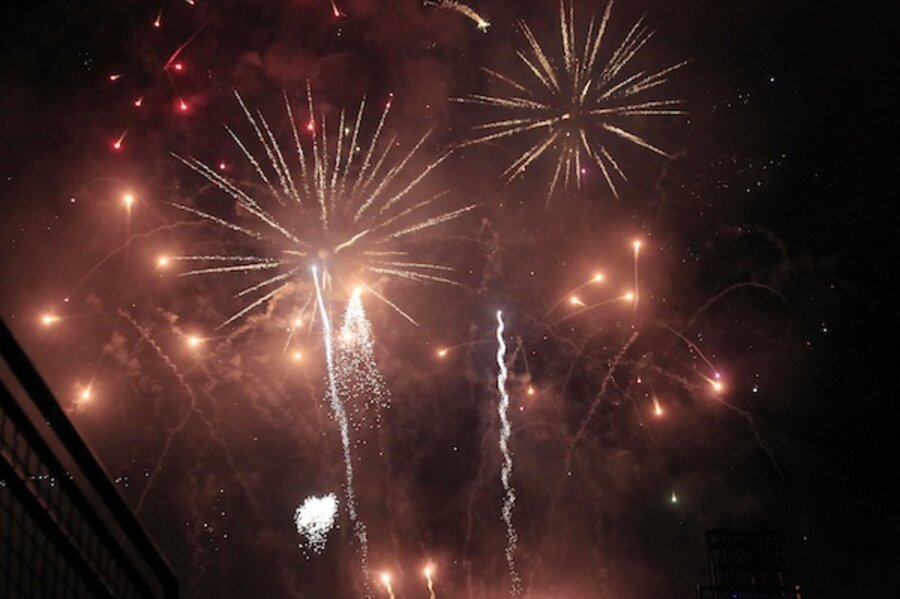Independence Day: Do July 4 droughts hurt fireworks sales?
Loading...
As wildfires raged this week across the drought-ravaged state of Colorado, Americans across the country were transfixed by the images of destruction streaming out of the region. But on the eve of the Independence Day holiday, a few select businessmen may have been watching those telecasts with a certain sinking feeling in their stomachs.
According to the National Retail Federation, this Independence Day more than 160 million people, or over 67 percent of Americans, plan to celebrate the patriotic anniversary with cookouts, barbeques and picnics. Nearly half of those celebrating, or close to 115 million people, are planning to attend a fireworks or community celebration.
They won’t be catching a display in Vail, Colorado, however. Not this year, anyway. Fireworks displays in the popular vacation destination have been canceled due to the extremely dry conditions and high fire risk, with nearly 400 wildfires reported in the state so far in 2012. And it’s not just Vail. On June 14, Colorado Governor John Hickenlooper signed an Executive Order banning open burning and private use of fireworks statewide.
On top of potentially putting a damper on the celebrations of many state residents, the Governor’s actions is potentially bad news for the fireworks industry, which earns a majority of its revenue in the few weeks leading up to the holiday.
“Its something that we do have to watch very, very closely,” says Julie Heckman, executive director of the American Pyrotechnics Association (APA), a trade group that represents a whole gamut of different fireworks companies. “Mother nature will impact the 4th of July, whether it be storms like Tropical Debbie in the south, or hurricanes or even the storms we’ve experience last week which caused some cancellations in the D.C. area.”
Canceled shows can be rescheduled, Heckman says, predicting a spate of Labor Day shows to be slated this year in Colorado. And the larger, experienced companies know not to put all their proverbial sparklers in one basket.
“Most companies… they diversify,” Heckman says. “If you’re in an area that typically has restrictions because of drought, you will also do business in states not prone to such restrictions. So you’ve basically balanced your financial risk. If you did business in Texas, you would be quite wise to also do business in New England.”
But dry weather and burn restrictions can still hurt various players in a retail industry that has over the past decade been steadily increasing in both reach and revenue — even as the actual production of American fireworks now takes place almost exclusively in factories in China.
“In certain areas, sales are down,” says William A. Werner, Vice President of the consumer fireworks behemoth Phantom.
“Weather patterns the last six months have been pretty weird,” Weimer says. “But this was unusual. Typically we don’t have these kinds of extreme weather conditions in multiple locations.”
On the other hand, Weimer is not particularly worried.
“Where there are not adverse weather conditions sales are very strong, so it’s really a dichotomy out there,” he says. And the last two years, even despite dry conditions in Texas and northern Florida still resulted in positive gains.
These things just come with the territory, according to John Werner, a member of the board of directors of the National Fireworks Association, another trade organization that deals mostly with the types of smaller retailers most vulnerable to burn bans like the one issued in Colorado. Weimer has been involved with professional pyrotechnics for going on 30 years, and has weathered plenty of droughts--and storms--along the way.
“It’s a finicky kind of business,” Werner says. “And the people who get involved with it are used to dealing with the whims of the weather, and the regulations, which can change from year to year.”
It's also an increasingly profitable business. In fact according to figures from the APA, fireworks sales in the US have doubled since 1998, and states that allow consumer sales can look to bring in between $500,000 and $1 million dollars a year in tax revenue alone. Fourteen years ago, fireworks companies earned $141 million in revenue through large-scale displays, and another $284 million was made in consumer sales. By last year, those figures had risen to $318 and $649 million, respectively.
“Personal sales, that’s where this industry has really grown over the past decade,” Heckman says. “We’ve seen a significant trend in states liberalizing sales since 2000.”
Perhaps due to reported decreases in the number of fireworks-related injuries, or perhaps due to the ever-increasing potential for tax revenue, in the ten years a dozen states have regulations on the fireworks purchasable in stores, including six legislative alterations in the past two years. Currently, only Massachusetts, Delaware, New York, and New Jersey maintain all-out bans.
If you do live in a state that is in the middle of a dry spell, check with your local fire department for updates on possible firework restrictions or burn bans. Fires sparked by inappropriate or banned firework usage are not only dangerous, they're illegal.
If consumer fireworks are legally sold in your area, John Werner of the NFA says a rather cutthroat industry and very small selling window helps ensure prices stay affordable. “Apples to apples everyone is pretty much on the same page,” Werner says. “In a lot of cases it’s a friendly rivalry to outsell each other. Everybody knows what everybody else is doing.”
In terms of variety, as well as the best possible bang for your buck, families with children can never go wrong with a good assortment kit, adds William A. Weimer, of Phantom.
“The reality is 65 to 70 percent of our buying groups are families,” he says. “It’s becoming more and more a family oriented experience, rather than just some boys blowing things up.”








